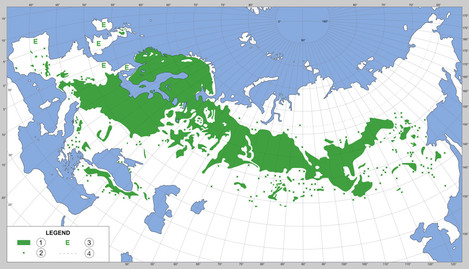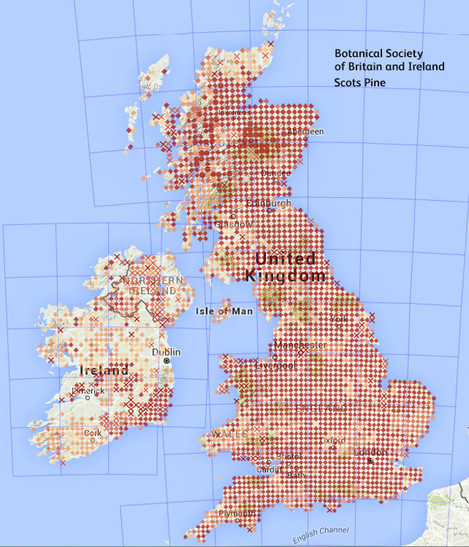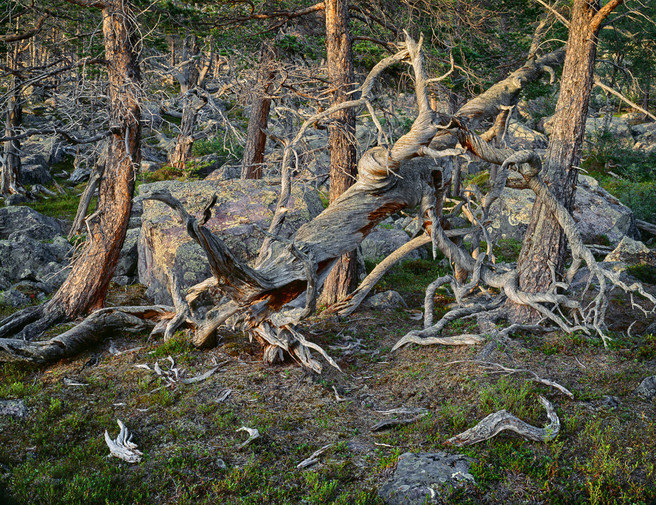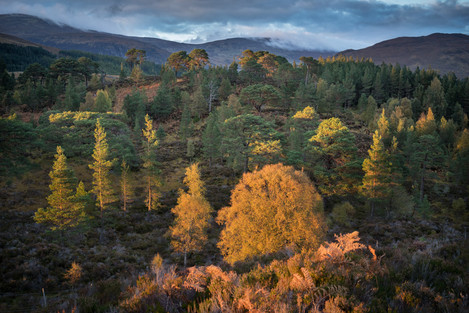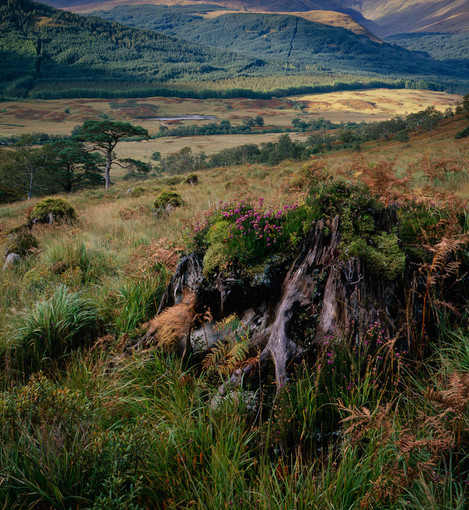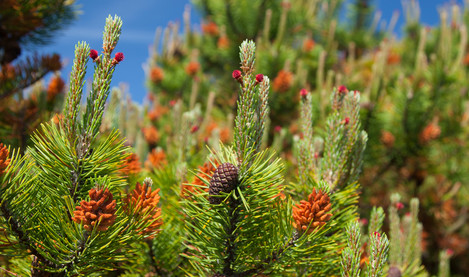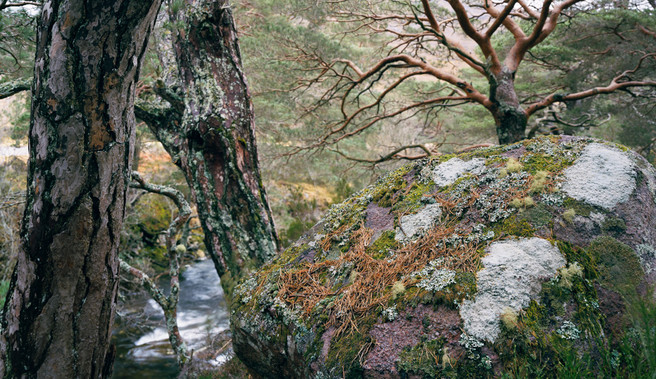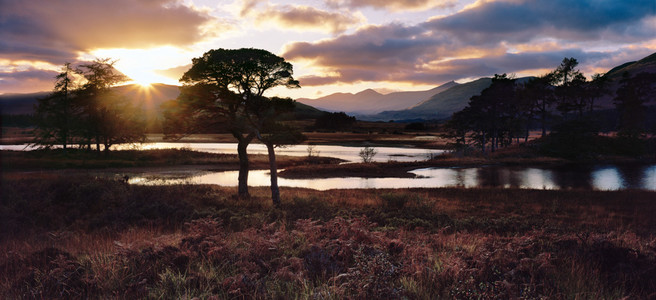Know your Subject

Tim Parkin
Amateur Photographer who plays with big cameras and film when in between digital photographs.
The humble Scots pine is the only truly native coniferous tree in the United Kingdom and what a beauty it is. The trees you see now are a small fraction of the 6,000 square mile Caledonian forest that swept into Britain following the last ice age 9,000 years ago or 7,000BCE - just before the English Channel appeared. There were actually two waves of invasion and subsequent to its isolation the tree genetically evolved/mutated until it became a species unique to the UK (although the closely related species is spread across Eurasia from Spain to Siberia).
The Caledonian forest would also have featured birch, rowan, aspen, juniper and oak (and some others) but it would have been the Scots pine that dominated (apart from on the far west coast where a temperate rainforest of lichen and moss draped oak took over).
Around 2000BCE, both the change in climate and human activities reduced the extent of the forest considerably and now there are only 84 recorded remnants spreading over 70 square miles.
Despite being the national tree of Scotland, the Scots pine is actually widespread across the whole of the UK as you can see in the map below.
Photographing
For photographers, the tree has much to offer. It has very distinctive layers of foliage that form strong and well spaced platforms that, as well as their ‘stag head’ crowns, give the tree their varied outlines. The bark forms in scales or ‘plates’ ranging from a pale pinky-grey to a rich orange-red or maroon towards the crown of the tree. The plates flake off to reveal a beautifully contoured and richly coloured surface. Scots pine are also susceptible to twisting and distorting, either through environmental stress or infection, that create spiralling branches - best seen in this wonderful image from Hans Strand.
One of the most compelling features of the Scots pine is its adaptation to different conditions. In good, well drained conditions they form typically pine like shapes standing tall at up to 25 meters or more. However, they are equally as happy in boggy ground where you will find smaller, contorted trees, sparsely placed and with buckets of character. They are also happy clinging on with minimal soil, often seen at the edges of mountain paths or on craggy knolls. In fact the Scots pine seem more at home in harsh conditions, even preferring darker, damper north facing slopes.
Environment & History
This adaptable tree is not without it’s own challenges though. Much of the damage caused wasn’t significant until the 17th and 18th centuries when industrialisation (wood for iron and glass making) and shipbuilding took a heavy toll on the landscape and the increase in sheep and cattle farming subdued its regrowth. Samuel Johnson visited the highlands and while remarking that it was a vile country he also commented “The country is totally denuded of its wood, but the stumps both of oaks and firs [scots pine], which are still found, show that it has been once a forest of large timber.”
The second, and probably worst, wave of damage was caused by the war effort during the 1st and 2nd world wars. Because of Britain’s isolation from Scandinavian countries, a domestic supply of wood was needed and Scotland was to be it’s source.
Following the war, the Forestry Commission was born and despite the chance to replant Scots pine, they decided to plant Norway spruce and then sitka spruce. Despite a few ‘reserves’ being created - Beinn Eighe, Glen Loy, Glenmore, Invereshie in the 1950s and Glen Affric in 1961 - it was only in the 1970s that a major movement was made to protect the ancient forests through Sites of Special Scientific Interest (SSSIs). In 1988 £1.8m was raised to purchase Abernethy forest for the RSPB and a year later ‘Trees for Life’ was formed to act as a focus for conservation efforts. Deer culling efforts were undertaken and evidence showed they worked well and in places such as Beinn Eighe, deer ‘exclosures’ allowed the forest to grow at its natural rate - surprisingly fast!
The future for the remnants of the Caledonian forest has never looked better. Replanting is happening regularly and there is a growing acceptance that culling the deer population will have many benefits above and beyond the recovery of this wonderful natural resource.
There are still problems though and one of the biggest seems to be that of disease. We’ve already seen elm disease and its catastrophic consequences and ash die-back is well known but there are other diseases that could potentially be as bad. Scots pine is considered to be particularly vulnerable to the pine wood nematode, a worm that infects pine trees and causes pine wilt, and the fungus Fusarium circinatum, which causes the disease pitch canker. Pine wilt can be identified by a browning of a whole branch and eventually the whole tree, pitch canker shows itself with excess resin production making branch tips or whole branches wilt and die. These diseases have already established themselves in France and Spain and it is thought they may well be in Kent already. The remote nature of many of Scotland’s forests may give them some modicum of protection however.
Biology
The Scots pine puts on quite quite a display as it has both male and female reproductive parts on the same tree (Monoescious). They can both be seen on the photo above. The male parts start yellow but end up an orange colour anthers and the female parts are the rich magenta parts near the tops of the shoots. After pollination, the female flowers turn green and develop into the pine cones. These mature the following season which is why you seen both on the tree at the same time.
Other Facts
Well if you’ve got a love for bitter foods, the vikings used to chew on Scots pine sap as a sort of chewing gum.
The Scots pine was used to fuel the furnaces at Bonawe to make the iron for cannonballs used against Napoleon.
In the US the Scots pine (or the Scotch pine as it’s called in the US) is one of the most used species for Christmas trees. It doesn’t shed its needles as much as other trees and has sparse, strong branches for hanging decorations off. This means that Charlie Brown’s straggle specimen was probably a Scots pine!
Turpentine and Rosin are both extracted from Scots pine as is the ingredients for a classic Scottish ale that is still made, see Alba Scots Pine Ale.
Where to See Scots pine
Although the following list is no means comprehensive it should give you a flavour of the types of location you can see Scots pine. If you have any personal favourites, please let us know in the comments below.
Loch Maree
The edges and islands of Loch Maree (here's video of Joe Cornish editing on of his images from Loch Maree) present an amazing array of mature Scots pine. Make your own agenda here but you could do worse than stop at Bridge of Grudie and having a wander around.
Glen Affric
Glen Affric is a National Nature Reserve and one of the largest remaining fragments of the original Caledonian forest that stretches from Kintail in the west to Cannich, Strathglass. Access is easy with three car parks along its length. There are numerous marked (and unmarked!) paths.
Guides & Links:
Forestry Commission, Glen Affric
Loch Tulla
One of the best known Scots pines are probably the two that sit on the banks of Loch Tulla in Argyll, Scotland. These have been photographed ever since the 1970’s (and most likely earlier) by Eddie Ephraums, Paul Wakefield, Joe Cornish and David Ward and many people since. Here’s a couple of my own efforts at that particular tree. Oh and don’t forget to turn around when you’re visiting too as there is a whole forest of great looking specimens right behind you on the other side of the road (although more deer fencing put up last year is making things more difficult). The area is privately owned but access has not been a problem in our experience.
Buttermere
The famous line trees at the end of Buttermere in the Lake District are a photographic favourite but how many people knew they were Scots pine?
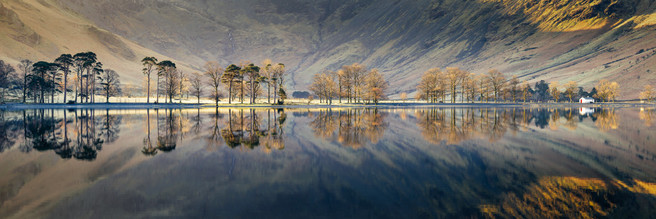
Colin Bell - colinbell.photography
Abernethy & Glenmore
Well known for its Osprey viewing site, Abernethy is more a forest to get lost in that to observe from outside. It has some wonderful trees close to the water's edge though and the road through the forest is quite picturesque (good bike route too!).

Tim Haynes - shinyphoto.co.uk
Guides & Links:
SNH, NNR, Forestry Commission, Visit Scotland
Ullswater
The banks of Ullswater may not have the forest of Scots pine but the examples it does have are in some of the most beautiful settings. Walk around the path on the eastern side of Ullswater and you’ll come across some great specimens, especially at Purse Point
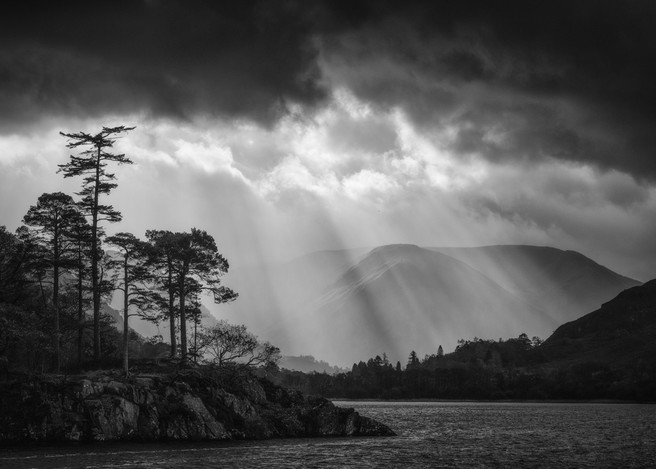
Mark Littlejohn - markljphotography.co.uk
Ashdown Forest
When I was first taken to Ashdown Forest by David Higgs I couldn’t help but draw the comparison with areas of Scotland that I know well. This is like a patch of the Caledonian that got lost after the ice age. David Higgs platinum palladium prints show the distinctive shapes of the Scots pine.
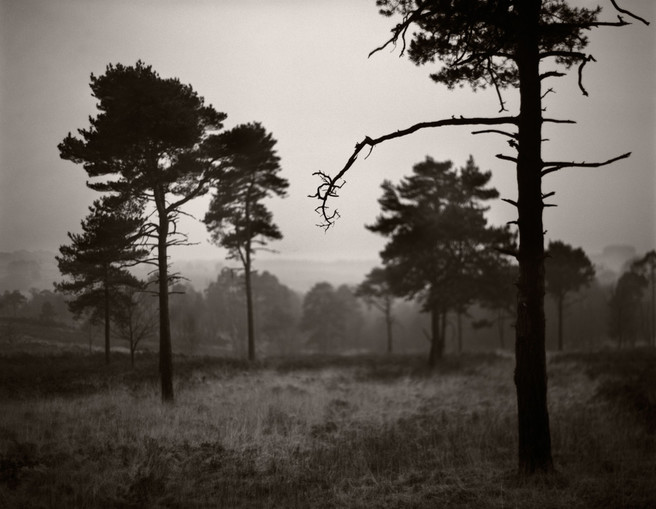
David Higgs - milesfromhere.co.uk
Colmers Hill, Symondsbury
There are the occasional stands of Scots pine throughout the country. Quite often small copses are left standing at the tops of hills and this is the case here. Alan Coles wonderful sunset picture shows them off well.
Glen Nevis
One of my favourite little glens in Scotland, Glen Nevis is a beauty and changes character as you walk towards it’s end with the very last south eastern section having some beautiful examples of Scots pine hanging off crags and precipices and also many individual examples hanging onto the edges of the river below (read Mark Littlejohn's latest article on his Glen Nevis Trip).
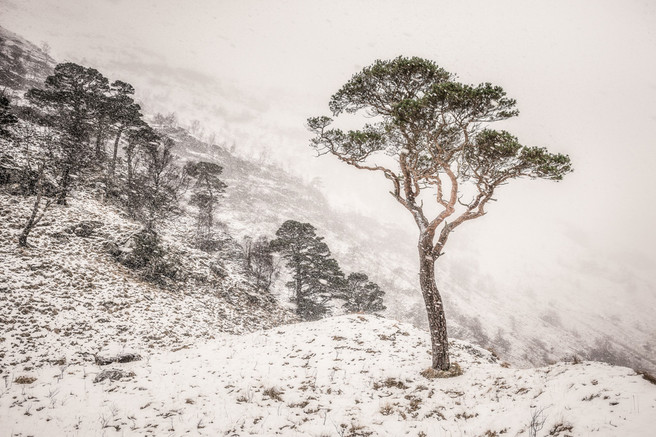
Mark Littlejohn - markljphotography.co.uk
Rothiemurchus
Between Aviemore and Carrbridge there stands a wonderful example of Scots pine forest that fades into blanket bog and montane heath. Some great views overlooking Loch an eilein too.
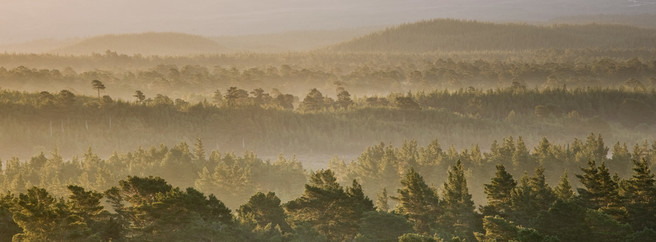
Jason Friend - jasonfriend.co
Finally I'd like to highly recommend a book called "The Ancient Pinewoods of Scotland - A Traveller's Guide" by Clifton Bain. A great treatise on the Caledonian forest's history, make up and where to find examples.
Contributed Photos
Loch Doon, East Ayrshire
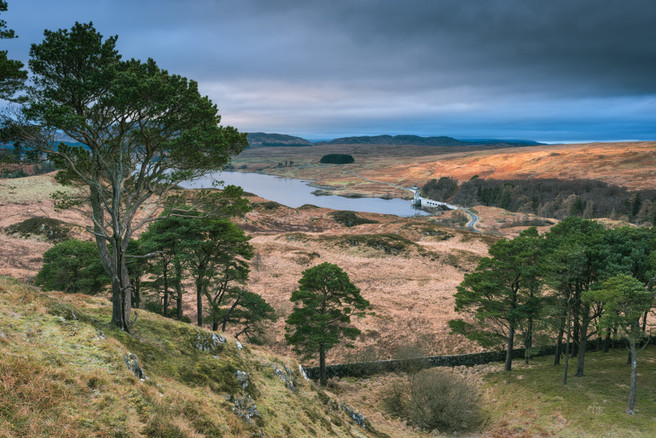
William Dore - Flickr
Glen Falloch, Nr. Crianlairich
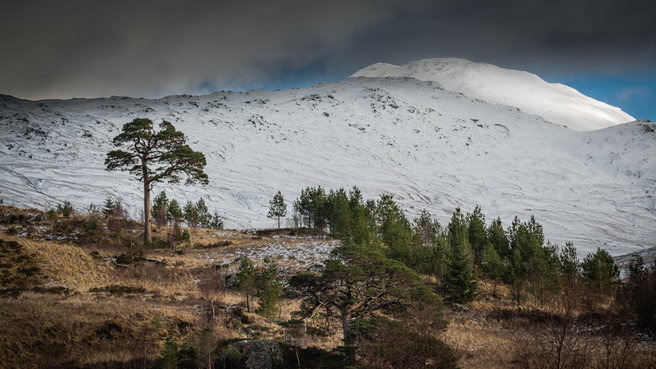
William Dore - Flickr
Beatlock Summit, Clydesdale
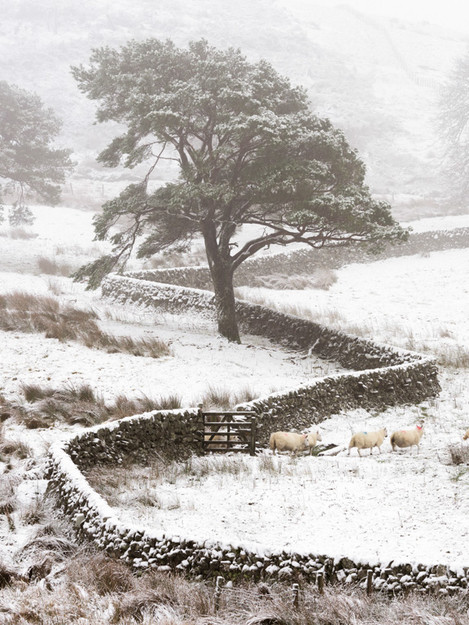
Dylan Nardini - dylannardini.com
Bratley View, New Forest
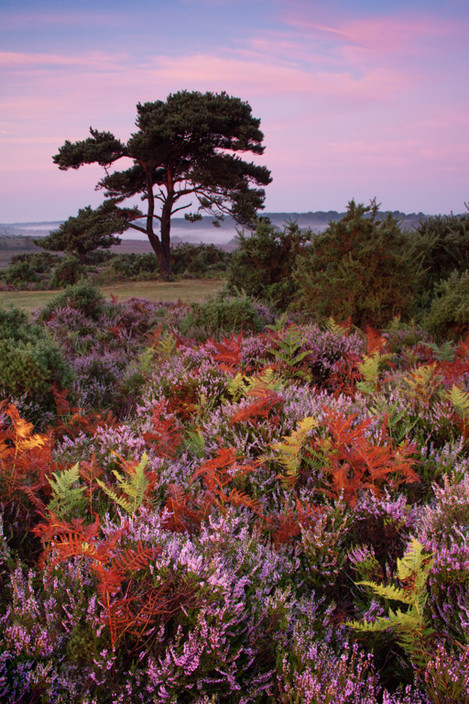
Andrew Stevens - andrewstevensphotography.co.uk
Portishead, Somerset
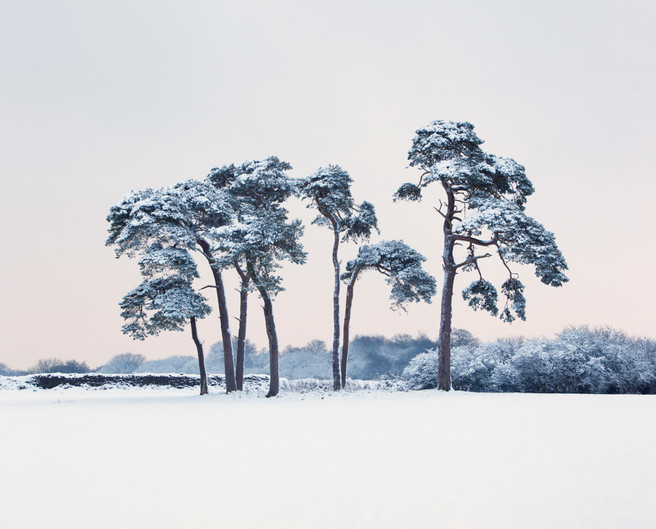
James Osmond - jamesosmond.co.uk
Just outside Oxford, near Beckley
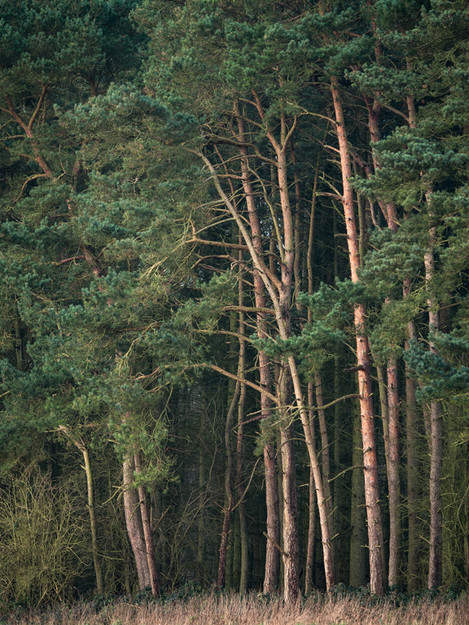
Damian Ward - Damian's Flickr stream


